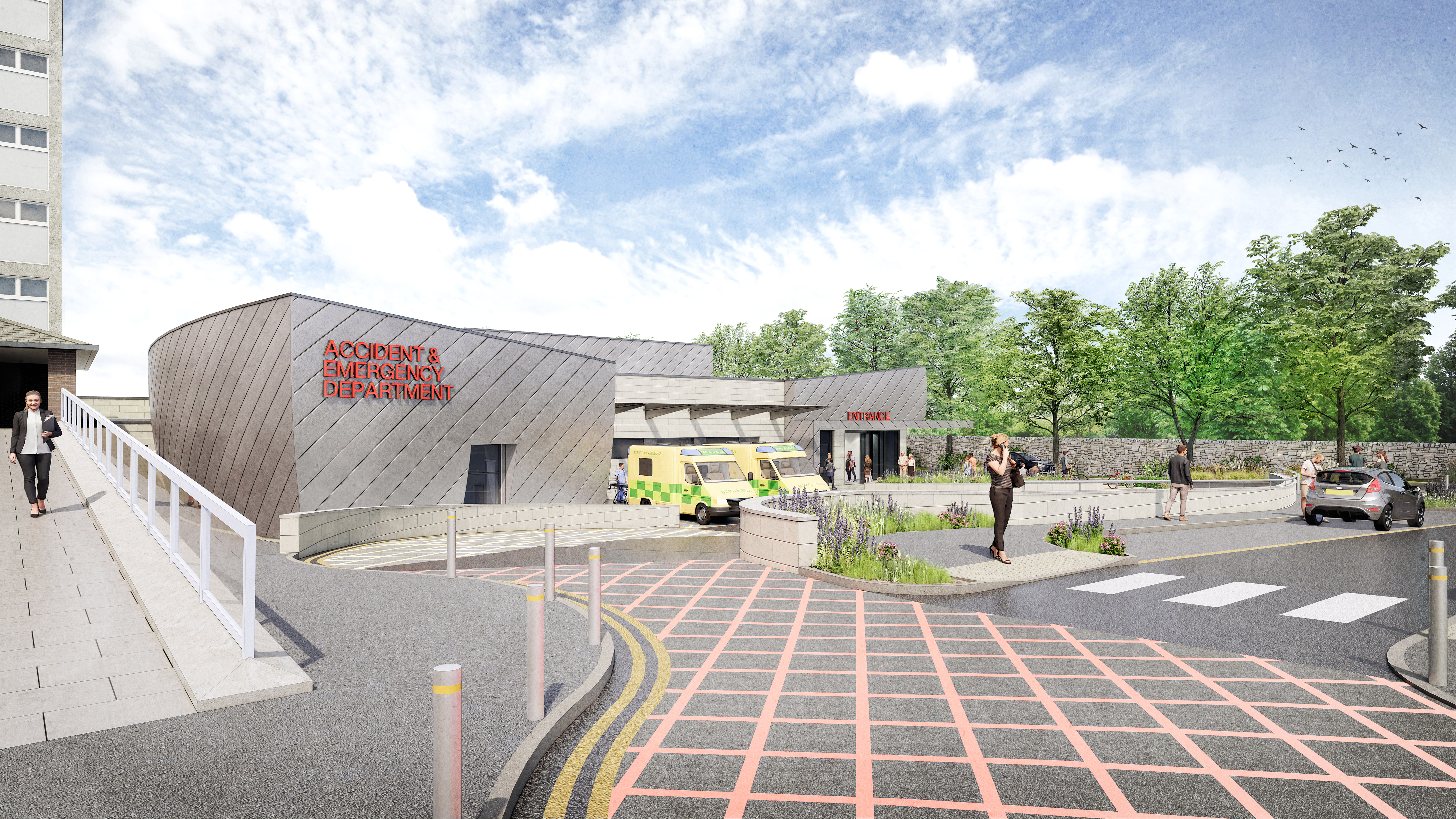
1. Introduction
This Statement of Community Involvement (SCI) has been prepared by Calderdale and Huddersfield NHS Foundation Trust (“CHFT” or “the Trust”) and outlines the detailed programme of engagement the Trust has undertaken for its development proposals at Huddersfield Royal Infirmary, HD3 3EA for a new Accident and Emergency department.
The engagement exercise has been undertaken in advance of the submission of a planning application for a proposed new Accident and Emergency (A&E) Department being submitted to Kirklees Council for consideration and determination.
This SCI identifies the comments made in relation to the proposal and how these comments have been considered by the Trust in advance of the submission of the planning application.
Background
Calderdale and Huddersfield NHS Foundation Trust has plans to invest £196.5 million in local health services and parking and travel arrangements at Huddersfield Royal Infirmary (HRI) and Calderdale Royal Hospital (CRH).
The proposals include a new A&EDepartment and a wider programme of essential upgrades to clinical care facilities including overcladding of the existing buildings at HRI and the construction of a new healthcare building and car park at CRH. This redevelopment of services would establish high-quality healthcare facilities across Calderdale and Huddersfield, delivering leading edge clinical services to improve patient safety and care.
The £196.5 million proposals are funded by the Department of Health and Social Care, and, pending the planning permission decision, it is hoped the work to build a new A&E at HRI could start this year, construction of the car park at CRH could commence in 2022, and construction of the hospital buildings at CRH commence in 2023 with all developments across both hospitals scheduled for completion by 2025.
Across both hospital sites, the proposed redevelopment has been informed by vital learnings from the Covid-19 pandemic. New healthcare facilities will be equipped with the ability to section off areas of the building, helping to strengthen infection control and resilience in the event of future outbreaks.
These developments will improve service delivery, provide improved clinical facilities and patient safety, and will enable compliance with national recommendations for estate and clinical service delivery.
Scope of consultation
A programme of stakeholder engagement with key politicians, officers, civic and community groups has also taken place to either inform about the project or to continue existing dialogue. CHFT colleagues, many of whom live local to the hospital sites, have also been engaged throughout this process. This work will continue throughout the project.
A single comprehensive engagement programme has taken by The Trust at the same time for both the development proposals at CRH and at HRI (for the proposed new A&E building and a wider programme of essential upgrades to clinical care facilities) to ensure that the public and stakeholders have able to consider the broader narrative and context for the proposals.
COVID-19 and the need for social distancing continues to impact pre-application processes, requiring applicants to pursue digital-first engagement campaigns. However, CHFT have made significant efforts to engage with the local community in a variety of ways, encouraging feedback via phone call, email, online survey and written responses. This has allowed us to reach beyond the traditional contributors to pre-application surveys.
Structure
This Statement is structured as follows:
- Section 2 - summarises the national and local planning policy requirements relating to public consultation
- Section 3 - describes the proposals for the new A&E Department
- Section 4 - explains the scope and methods of engagement
- Section 5 - describes the engagement with the local community and stakeholders which was undertaken during the pre-application stage
- Section 6 - identifies the main comments received during the consultation
- Section 7 - summarises the key themes and topics identified through the consultation and the Trust’s response to these comments and the approach taken by the Applicant to address these points
- Section 8 - concludes the report to summarise the outcome of the consultation process
2. Meeting the Requirement to Consult
This section outlines the planning policy context relating to consultation at both a national and local level which CHFT has fully considered and complied with in guiding its engagement strategy programme.
Consideration of National Policy and Guidance is set out below along with identifying the advice in Calderdale Councils Statement of Community Involvement Guidance.
National Planning Policy and Guidance
The National Planning Policy Framework (NPPF) (February 2019) acknowledges that early engagement has significant potential to improve the planning application system for all parties involved, in terms of both efficiency and effectiveness.
The NPPF recognises that this approach can result in improved outcomes for the community (paragraph 39).
The Government makes clear that Local Planning Authorities (LPAs) have a key role to play in encouraging other parties to take advantage of the pre-application stage. Where they think it would be beneficial, applicants should be encouraged to engage with the local community before submitting their applications (paragraph 40).
Furthermore, statutory consultees are also encouraged to engage in early pre-application discussions by adopting a proactive approach and providing advice in a timely manner. In doing so, this will help the developer to avoid unnecessary delays and costs (paragraph 41).
Planning Practice Guidance (PPG) provides further information on the process and expectations on the consultation of planning applications. The Consultation and pre-decision matters guidance of the PPG focuses on the requirements and good practice of the Local Planning Authority rather than that of the applicant.
However, the PPG notes that the pre-application process is collaborative and involves the prospective applicant and other parties. This may include the LPA, statutory and non-statutory consultees, elected members and local people.
Paragraph ref. 010 Reference ID: 20-010-20150326 of PPG states that although pre-application engagement with the community is not mandatory, it is encouraged where it will add value to the process and outcome.
The Applicant has considered this guidance when structuring its consultation strategy, specifically by:
- Informing the community of its emerging proposals,
- Enabling the community to put forward ideas and discuss opinions; and
- Ensuring consultation took place prior to the submission of the Planning Applications
The Localism Act
The aim of the Act is to increase public participation in the decision-making process and has emphasis on the planning process. The Act under Chapter 4 61W states:
“The person must publicise the proposed application in such manner as the person reasonably considers is likely to bring the proposed application to the attention of a majority of the persons who live at, or otherwise occupy, premises in the vicinity of the land.”
It goes on to indicate in 61X (Duty to take account of responses to consultation) that the applicant must take in to consideration responses made during the community consultation process.
The person must, when deciding whether the application that the person is actually to make should be in the same terms as the proposed application, have regard to any responses to the consultation that the person has received.
Kirklees Council Statement of Community Involvement
Kirklees Council’s adopted SCI (2019) includes several expectations for the Council itself over Local Plan engagement. This includes:
2.4 We will aim to consult relevant groups where a proposal will directly affect them. Generally we will seek the views of those who live or work in the district relevant to the document being consulted on such as: Residents; Adjoining local authorities; Parish and town councils; Specific consultee bodies – See Appendix 1 - organisations defined by The Town and Country Planning (Local Planning) (England) Regulations 2012 that are required to be consulted at key stages of plan production.
These include neighbouring and parish councils, key service providers, Government departments and non-government organisations; General consultee bodies – organisations defined by The Town and Country Planning (Local Planning) (England) Regulations 2012 that are required to be consulted at key stages of plan production.
They include bodies which represent Kirklees Statement of Community Involvement December 2019 Page 5 of 27 the interests of different racial, ethnic, religious or national groups, disabled persons and business in the local planning authority’s area; Interest groups; Voluntary organisations; Businesses; Developers and landowners; Marginalised groups - which includes those with protected characteristics under the Equality Act 2010, young people, elderly people, disabled people, and religious and ethnic minority groups; ‘Seldom heard’.
There is some overlap between marginalised groups and those ‘seldom heard’, who may be disengaged with the planning system. Additional effort should be taken to ensure that consultation is accessible to those who are seldom heard, rather than only those who usually engage with the planning system. Where a ‘seldom heard’ group is also a group with a protected characteristic, this is an important consideration in line with our duties under the Equality Act (2010).
‘Seldom heard’ groups include those who find engaging in planning issues less accessible for practical reasons – such as single parents, carers, those in full time or irregular work, rural communities and those without adequate access to or knowledge of the internet.
Furthermore, Kirklees Council’s SCI from 2005 says the following about pre-application community engagement in Section 5.3:
We encourage developers to carry out pre application consultations with the community and interested parties about their proposals before submitting a planning application. Even where the proposals will not be “Major Development”, developers should still consider the benefits of informing and consulting the local community. If requested we will advise on the people, groups and organisations that should be consulted. (Figure 1 provides guidance on options for consultation.).
We do not wish to be overly prescriptive about the required form of community consultation on individual development proposals. This will need to be tailored to the individual circumstances of sites and developments. However, we wish to be consulted on a programme for planned community involvement for individual sites.
The programme for community consultation on individual sites could typically include: Dates/times of consultation. Methods of consultation. Who is to be consulted and opportunities for on-going involvement. Feedback on consultation. How feedback will be addressed in development proposals.
3. The Development Proposals
Huddersfield Royal Infirmary – A&E Department Proposals
The A&E department will accommodate the following:
- Majors and Minors Treatment Areas
- Dedicated paediatric treatment areas
- Resuscitation bays and X-ray rooms
The A&E department is proposed as single storey building with a footprint of circa 1,800m2. Located primarily on part of the hospital estate currently occupied by Savile Court (a staff residential facility close to the end of its service life) and surface car parking to the south of the existing main hospital, it is proposed that the new A&E Department will extend across South Drive northwards towards the existing hospital.
By adopting this proposed arrangement, the new facility can be physically linked to the main hospital’s primary vertical and horizontal internal circulation system via a ground level single storey corridor between the proposed accident and emergency and the hospital’s existing south pedestrian entrance, thereby providing access to key supporting clinical facilities including Wards and the hospital’s Operating and Imaging Departments.
This investment improves our services at Huddersfield in many different ways including:
- Providing exceptional clinical services to allow our NHS staff to access advanced digital, medical and clinical technology and services – providing the very best healthcare for patients
- Allows us to incorporate learning from the Covid-19 pandemic
- Deliver improved patient privacy, dignity and observation
- Allow NHS staff to meet the ever-shifting demand on our A&E facilities
- In addition to the A&E works at HRI there are a number of other planned additional projects. These include:
- Refurbishing and improvements to wards and theatres.
- Replacing external cladding systems on buildings for structural reasons.
- Fire safety improvements.
- Wider maintenance across the estate
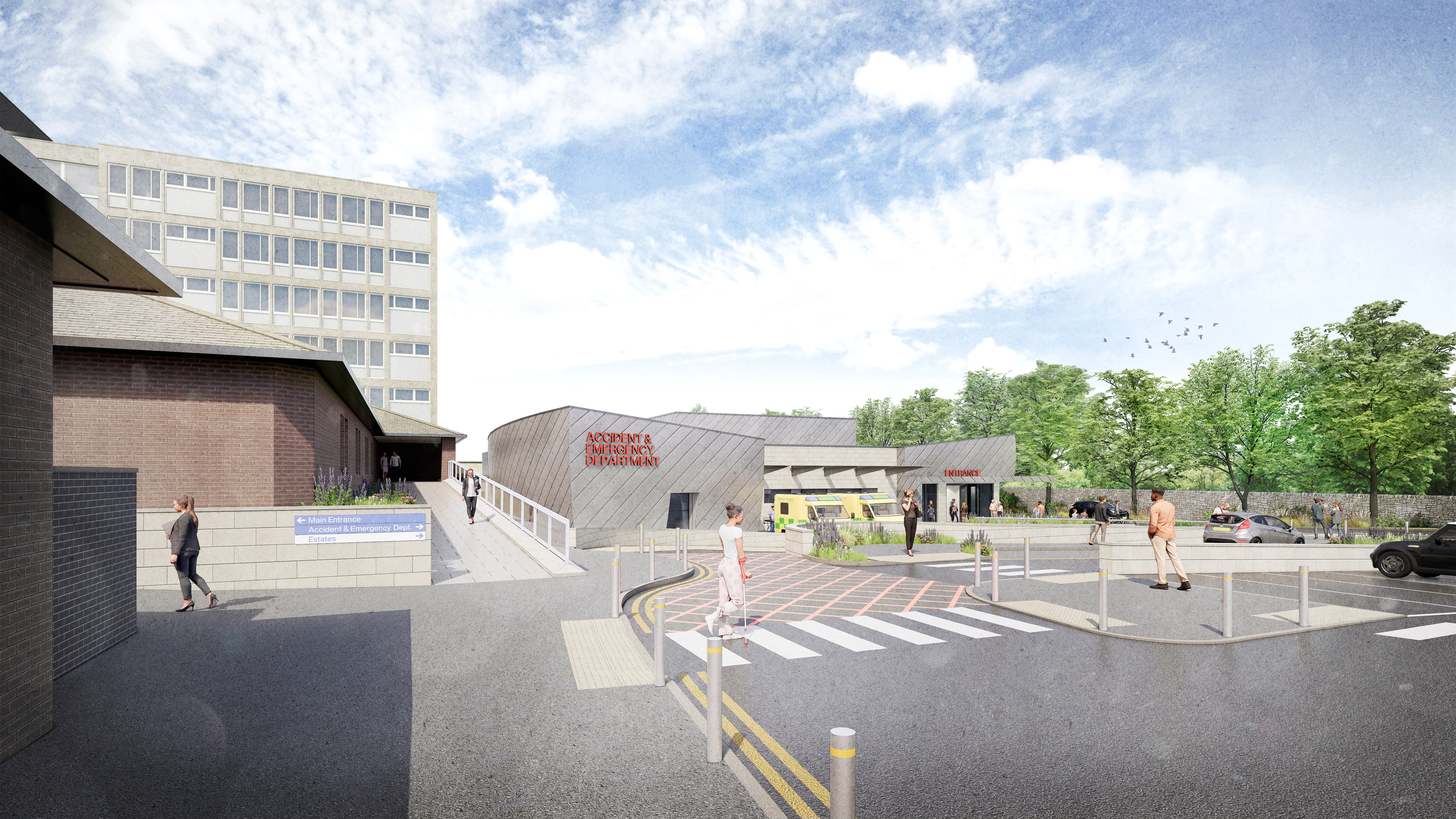
4. Public Engagement Activity
Pre-application engagement for both CRH and HRI draft plans
Due to COVID-19 restrictions, members of the public were invited to learn more about the project and provide their feedback via a digital consultation which ran from Monday 8th March – Monday 29th March 2021. However, feedback will continue to be accepted throughout the planning process to ensure all local residents and stakeholders can have their say.
To ensure that project information and the consultation is accessible to all, including those without access to the internet, residents living locally to the site received an information leaflet which included details on how to submit feedback via post, the website link and a phone number. The leaflet was posted to around 1,000 households (Appendix 2) in the vicinity of each hospital site on week commencing the 8th March 2021.
Additionally, a letter was sent to immediate neighbours of the site (Appendix 3) which included information about the plans and a phone number which they could ring to provide feedback and ask questions. The project team were made available to ring back residents who may have more detailed questions related to the draft plans. We received phone calls from residents and logged feedback. The feedback received via phone call and letter is included in this document’s analysis section.
Local press activity
A press release was sent to local and regional news outlets, announcing the proposed developments and outlining the engagement process. The release was distributed to Halifax Courier, Huddersfield Examiner, Yorkshire Post, Todmorden News, Brighouse Echo, Look North and Calendar. This release allowed the engagement to reach beyond the immediate neighbours of the site, as we appreciate the plans will impact the wider localities.
Coverage was received in several local and regional media outlets including both print and online.
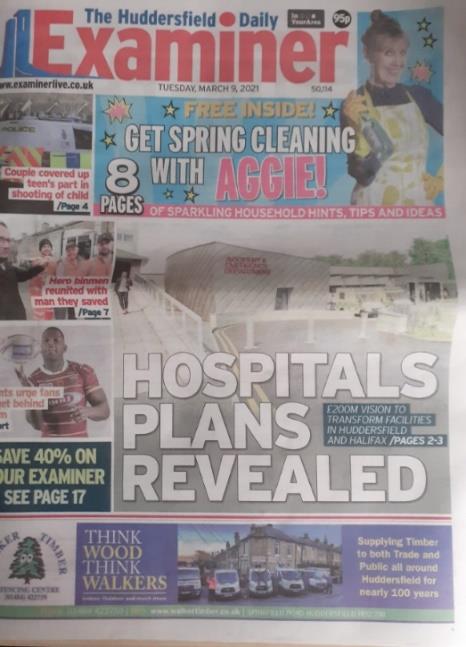
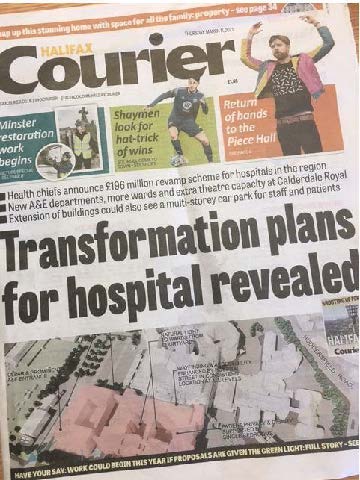
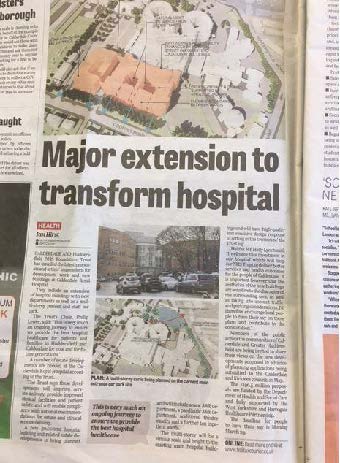

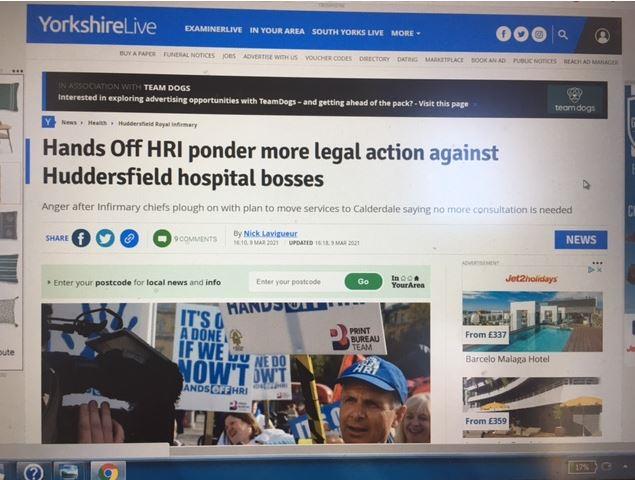
Website portal
The digital engagement was hosted via the project website at www.chftfutureplans.co.uk. Visitors to the site could find all of the information, which is normally displayed at a traditional consultation event, as well as an interactive map to clearly display information about the proposed development. The developments at CRH and HRI were displayed on separate pages with two feedback forms available to capture the views of local residents. There is also a page for Frequently Asked Questions (FAQs) about the project and an Accessibility Statement.
The website included an email address ‘hello@chftfutureplans.co.uk’ which residents could also submit wider feedback. We received 8 enquiries to this email address and have kept the address on the website for any further queries following the public involvement. The feedback received via phone call and email is listed as part of the analysis below.
Online coverage is available at the following weblinks:
- Multi-storey car park and new building planned at Calderdale Royal Hospital as part of £196.5m developments by Halifax Courier
- First pictures of new Huddersfield Royal Infirmary A&E revealed as part of £200m hospitals revamp by Examiner Live
Highlighting the public involvement with local businesses/community groups
During the pre-application public engagement, we were keen that immediate neighbours were made aware of and were able to engage with the process and feed back their views. These stakeholders included:
- Acre Pharmacist
- Blackhorse pub
- Cleveland House Care Home – BUPA
- Fibre Architects
- Lindley Grange Care Home
- Lindley Post Office
- Oakwood house Nursery
- Ramsdens Solicitors
- Sainsbury's Local
- The Bay Horse
- The Eden Centre - Lindley
- The Old Wireworks - Bar and Dining Rooms
- Thornhill Carehome
We worked with the local authority to identify and agree a list of stakeholder neighbours who received an A5 leaflet highlighting the engagement process. Separate phone calls and emails were made during the public involvement period asking them to submit feedback, share with their employees/networks and to share on social media.
Responding to potential gaps in feedback
Both surveys included diversity monitoring questions. During the public involvement process we monitored feedback and took several actions to help target increased engagement from underrepresented groups including currently or recently pregnant people and young people. This activity included:
Public involvement shared with:
- Better Births at Calderdale and Huddersfield Facebook page.
- Yorkshire Fertility Facebook page.
- Information sent to local authority partners to share with local Sixth Forms and Colleges.
- Healthcare students from Huddersfield University via CHFT colleagues.
- CHFT’s BAME network for colleagues.
- CHFT’s Youth Forum – a representative from the Trust spoke with young patients and carers and others.
Promotion at the hospital sites
Information banners were placed at entrances around CRH and HRI, directing people to the website. Given the COVID-19 context and social distancing measures, the banners were deliberately designed to not encourage gathering. The banners included a QR code which linked directly to the project website.
Extra copies of the resident leaflet were delivered to the hospital sites and distributed to hospital colleagues.
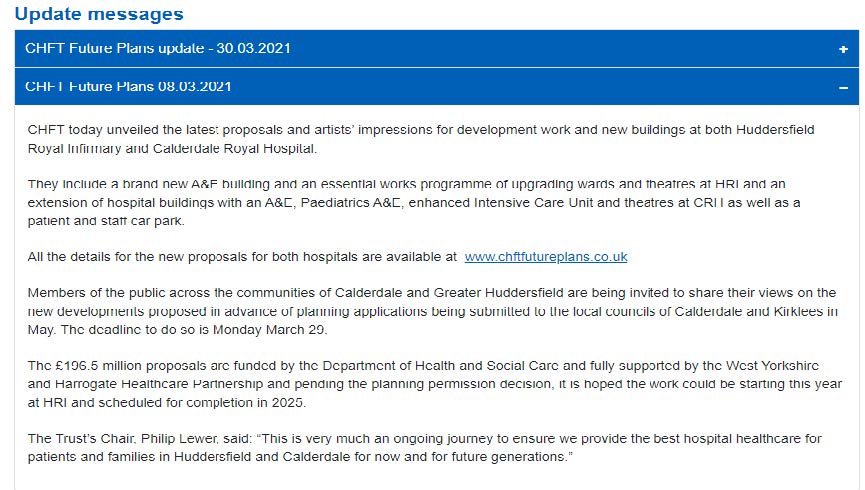
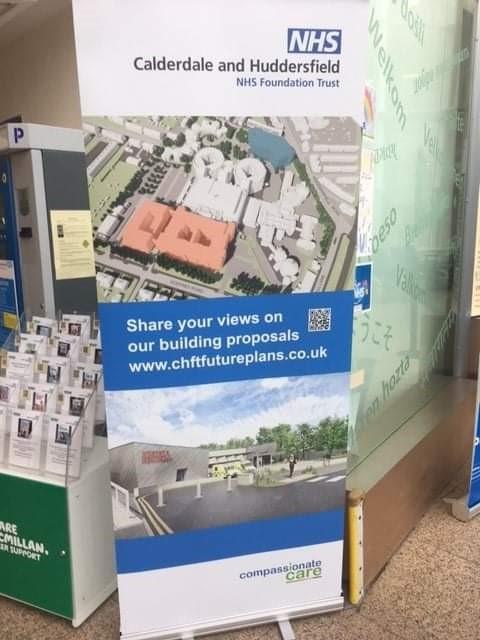
Social media activity
The project website was advertised across the CHFT Twitter and Facebook accounts. Several posts were published highlighting the engagement process, inviting people to learn more and take part.
The emphasis on promoting the involvement across social media was to ensure a more diverse and young population were reached. Posts like the below reached over 4,000 people and included over 500 engagements alone.
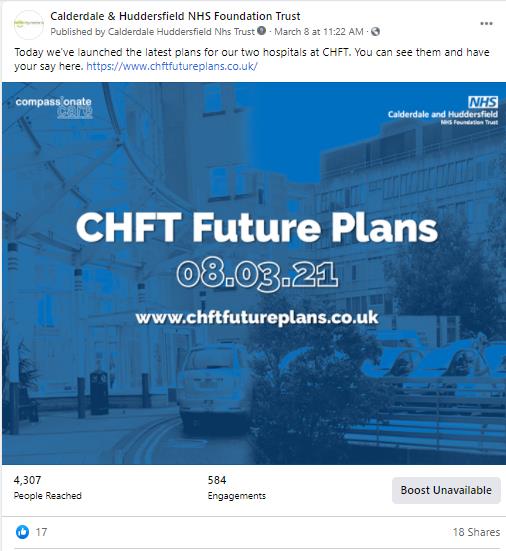
5. Stakeholder Engagement
Whilst there is existing understanding and stakeholder networks in place as part of CHFT’s Transformation Plan, a separate piece of stakeholder engagement on the planning applications was required.
Meetings took place and included a presentation with plans, timescales, and information about the planning process.
Each meeting included project team members such as planning consultants, architects, transport consultants and senior representatives of CHFT, and stakeholders were able to provide feedback and ask questions.
Meetings took place with the following:
- Ward councillors (Lindley and Greenhead).
- Members of Parliament (Holly Lynch, Craig Whittaker, Barry Sheerman, Jason McCartney)
- Meeting of Partnership Transformation Board (CHFT)
- Kirklees Council Cabinet & Corporate Leadership
- Kirklees Council Political Leaders
- Joint Scrutiny Chairs and Officers & Place Based Scrutiny Chairs
- Kirklees Council Planning Leads
- Briefing meeting with all Kirklees Councillors
- Kirklees Council Planning Leads
- Pre-application presentation to Members of the Strategic Planning Committee
These sessions brought stakeholders up to date with progress and outlined the proposed public involvement process. All stakeholders were interested to hear more about the proposals and next steps for the Trust in consulting with local residents.
Key discussion points included:
- Advice on public involvement – keen to ensure that vulnerable/digitally excluded local residents are able to contribute.
- Keen to address longstanding parking issues around both hospitals.
- The design and appearance of hospital buildings and the car park.
- Whether trees will be retained on both sites
- Interest in the digital improvements the new hospital sites will provide.
In addition to engagement with the above stakeholders, CHFT and the project team have held extensive discussions with the Council’s planning officers and others within the Council including highways, design and heritage officers. These ongoing discussions have shaped the proposal and ensure the submitted documents are sensitive of local considerations.
Engagement with CHFT staff
CHFT employ around 6,000 staff, many of which are also local residents, so significant efforts were made to raise awareness of this process and invite feedback. CHFT held around 20 meetings before and during the public involvement process with groups across the Trust, including:
- Staff Management groups
- Matron and Nurse Forum
- Ward Managers
- Learning and Development Centre team
- Senior management and leadership teams
- CHFT BAME group
Schedule of Colleague Briefing
| Forum/Meeting | Date |
|---|---|
| CHFT Leadership Meeting | 10th February |
| Council of Governors | 11th February |
| Consultant Forum | 18th February |
| Staff Management Partnership Framework | 24th February |
| Community SMT | 22nd February |
| Child Development Service Briefing | 23rd February |
| Medicine Huddle | 25th February |
| FSS Meeting | 25th February |
| WOD Weekly Meeting | 2nd March |
| THIS Big Brief | 3rd March |
| Matron and Nurse Forum | 5th March |
| Ward Managers | 5th March |
| HPS Reconfiguration Update | 8th March |
| Learning and Development Centre Team Meeting | 10th March |
| Surgical DMB | 15th March |
| CHS SMT | 16th March |
| Finance Team Briefing | 17th March |
| Quality Directorate Reconfiguration Update | 17th March |
| Corporate PA’s Time out | 24th March |
In addition, the following actions were taken to highlight the engagement process to staff:
- Publicised in weekly all-staff e-bulletin.
- CHFT project team regularly visited staff areas to discuss plans and leave feedback leaflets.
- A5 leaflets left in communal areas (leaflet available in Appendix 2).
- Publicised on CHFT’s intranet and website.
- Many screensavers on Trust computers changed to highlight engagement.
- 12 Pull-up banners displayed at entrances and staff areas across CRH and HRI.

Next steps for stakeholder engagement
Following the conclusion of this pre-application public engagement, CHFT will continue to regularly update key stakeholder groups and others on the status of the planning applications.
6. Survey Responses Submitted
Members of the public had access to the project website at www.chftfutureplans.co.uk which included dedicated project pages for Calderdale and Huddersfield. An interactive map was also available which showed where the proposed developments would be situated, and surveys were available to complete for both sites. Alternatively, local residents without access to the internet could submit their feedback via post and a phone number was available for local residents to ring and provide feedback.
The digital feedback form includes the following questions, designed to invite specific feedback which will help drafting the final schemes, as well as options for wider feedback.
The survey was split into three sections, the first allowing us to understand the contributor’s relationship to the hospital and how often they visit. The second is the main survey which invites specific feedback about priorities for each site and what they want to see delivered. The third section was equality monitoring which allowed CHFT to understand any emerging gaps in response rates and respond to these during the public engagement period.
This SCI includes feedback from the Huddersfield survey.
Feedback from the survey questions



Key feedback at a glance:
- 167 surveys completed.
- Obvious and logically positioned entrance is the most important factor (78%)when arriving at a new potential A&E, closed following by adequate parking (77%).
- Easy navigation (78%), good facilities (73%) and privacy for visitors and patients (71%) are the major priorities for contributors when visiting or working in the A&E.
- Sustainability (69%), a positive contribution to its locality (57%) and a high quality, durable finish (57%) are the major factors for contributors in making a new A&E a positive contribution to our hospital.
Location of feedback
- The proposed development at HRI can improve healthcare facilities for residents from across Huddersfield and the wider area. 25% of survey responses were received from Lindley ward which is reasonable as planning applications directly affect the very nearest residents. Other Kirklees wards including Greenhead (7%) and the Holme Valley wards (7% each) were represented.
Who responded to the survey?
- 22% of responses were submitted by CHFT staff. It is important however to consider that the majority of these will also be local residents or living near to the site.
- 21% identified specifically as residents in the local area, with 12% as living near the hospital and 22% a patient. 12% were parent/carer/family of someone who uses hospital services and 11% none of the above.
Equality Monitoring
- CHFT included equality monitoring questions within the website survey. This allows us to understand more about the backgrounds of those responding, make efforts during the involvement to target feedback from underrepresented groups and gain data which can help inform future work.
- It is important also to reference that responses to planning consultations are often skewed against underrepresented groups like young people. This is a wider issue, but one we are keen to identify and help address.
- We have cross-referenced the below feedback with available ward data published by Kirklees Council to understand if our response data reflects the local area. Lindley ward data is available here: https://observatory.kirklees.gov.uk/profiles/profile?profileId=108&geoTypeId=27&geoIds=0%200CZGX
- Whilst there are limitations in analysing a fairly small data set alongside the data for the entire ward, we have drawn out some key findings:
- Male were underrepresented - 34% of survey responses compared to 48% of the wider ward population
- People over 65 were very accurately represented – 27% of survey responses compared to 20% over 65 of the wider ward population
- Young people were underrepresented with 2% 24 and under compared to 33% of the wider ward population.
- The racial background of contributors is broadly reflected in the wider population, with 87% identifying as White compared to 82% of the wider ward population. Asian, Asian British/ (Bangladeshi/Pakistani/Indian/Chinese) were underrepresented with around 3% responding to the survey compared to around 9% of the ward population.
- 13% responding to the survey identified as disabled, and whilst this data was not available to us, we can be confident this is a strong representative number.

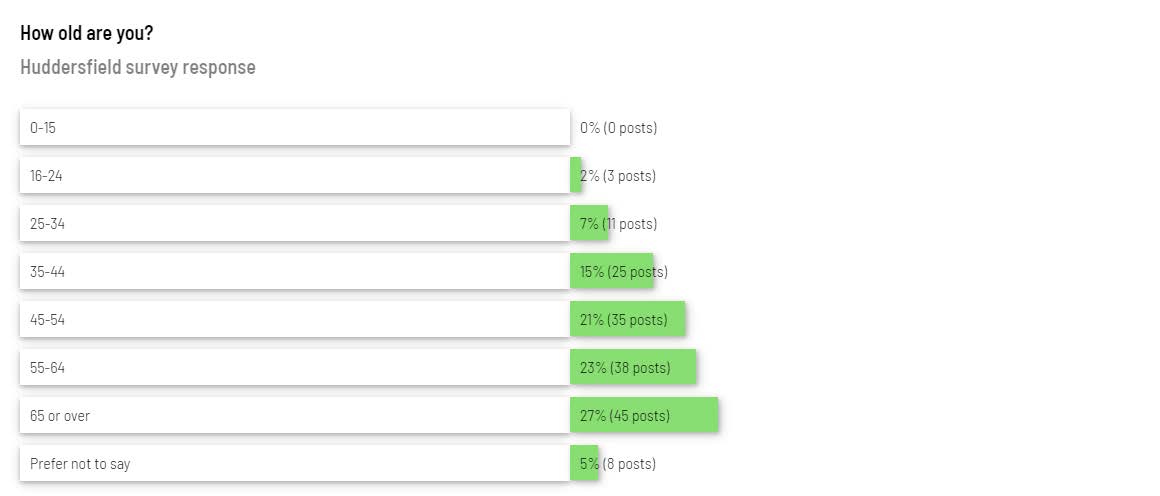
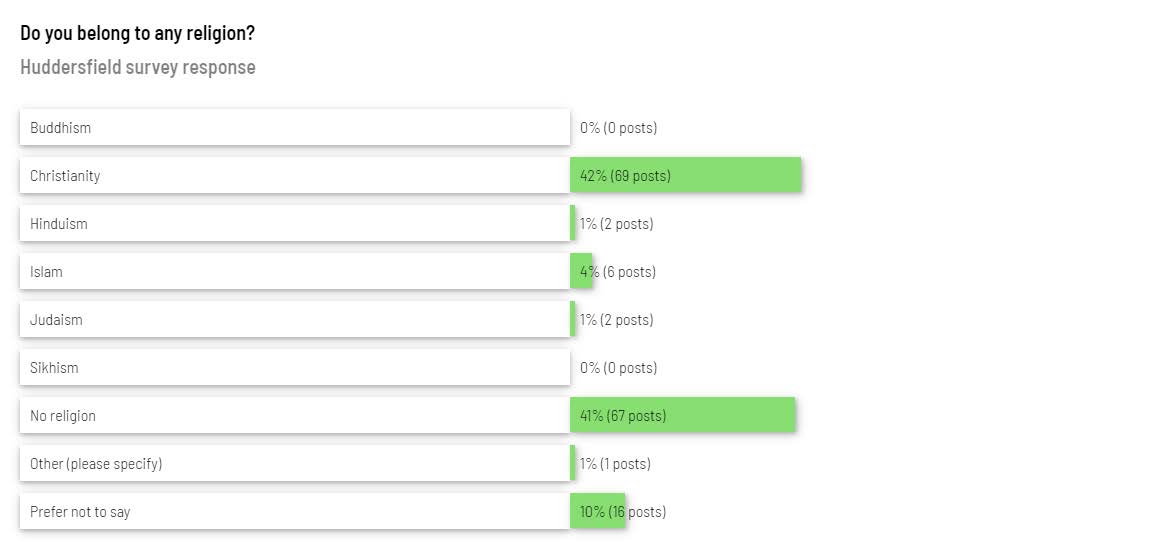
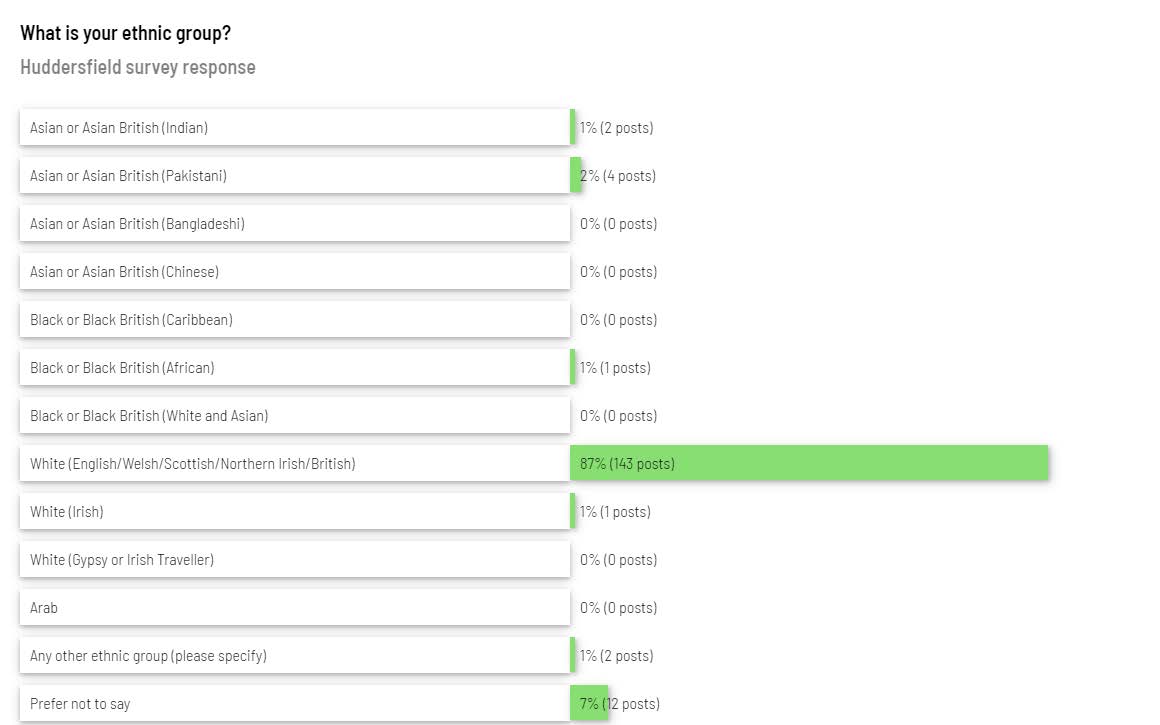

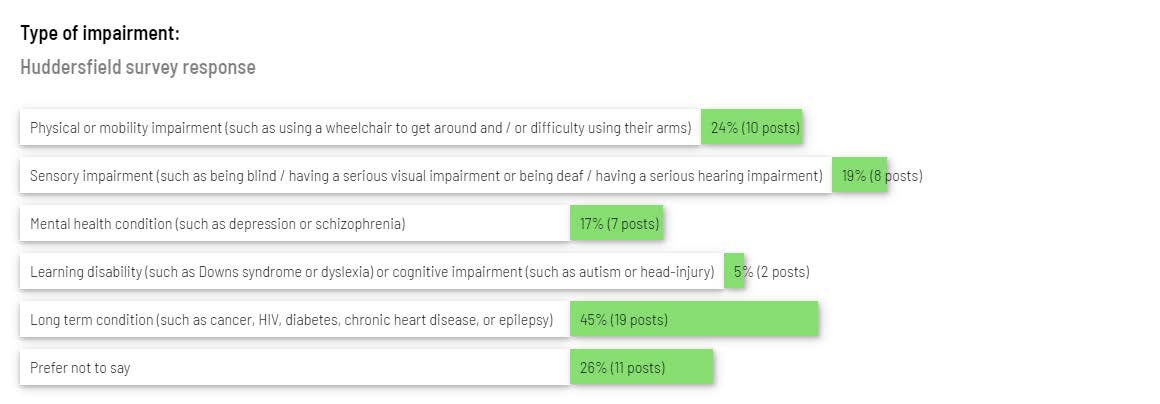



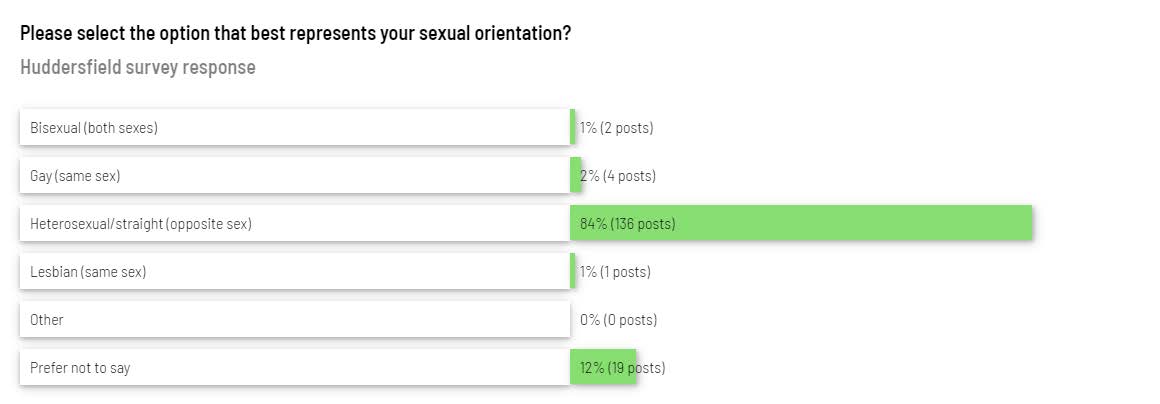

Overview of wider survey feedback topics
Transport
- Supply cycle parking and other sustainable measures.
- Ensure HRI plans consider sustainable travel modes, including access to buildings for those with disabilities.
- Concern about increased traffic for those travelling between HRI and CRH.
New A&E building
- Building should be welcoming and well signposted. Consider use of signs in different languages to reflect the local population.
- Plan the capacity of the new A&E and wider hospital services on sound and reliable data.
- Ensure the A&E is future proofed to take into account a growing population.
- Good ventilation – with COVID-19 learnings in mind.
- A drop-off area should be provided near the entrance.
- Ensure the building is an attractive environment for staff – break areas, staff rooms, outside areas etc.
Future of Huddersfield Royal Infirmary
- Ensure hospital provision and services continue to serve the people of Huddersfield.
- Invest in the wider HRI estate and upgrade facilities.
- Provide sufficient office space at HRI (for Allied Health Professionals specifically).
Feedback received from the website email, written and phone conversations
In total we received 8 pieces of feedback from people emailing ‘hello@chftfutureplans.co.uk’, writing to us or contacting the phone number on the leaflets or resident letters.
All feedback has been considered by the project team. The issues and feedback raised in these phone calls and emails include:
- Support for the proposals at Halifax, as parking has been an issue for local residents for many years.
- Requesting further information about whether nearby trees will be affected.
- Concern about building noises should plans go ahead.
- Requesting a print-out copy of the website information
- Passed on feedback about the positioning of the proposed A&E at HRI and traffic along nearby roads.
- Suggestion that CHFT look at including a shuttlebus to reduce requirement for parking spaces on-site.
- Concern about the scale of proposed buildings and impact on nearby residences.
7. Response to Comments
Following this robust consultation process, the project team has closely reviewed all feedback. Each discussion topic raised is included below and the project team’s response.
| Topic raised | Project team's response |
|---|---|
| Increased traffic between CRH and HRI and on local roads | A site wide Travel Plan (TP) has been produced and approved by the Trust. The purpose of the TP is to implement measures aimed at reducing vehicle traffic to the site and encouraging more sustainable travel modes. The TP and its measures would aim to reduce the proportion of staff and visitors travelling to the Hospital by private car over the lifetime of the TP and actively encourage modal shift. |
| Noise during construction | Noise control during construction will be an important requirement of the appointed contractor, not only with respect to the impact on the hospital itself but also on the hospital’s neighbours. The appointed contractor has been selected from NHS England’s main contractor framework and can evidence extensive experience in the construction of healthcare facilities on constrained sites. The proposed construction methodology is unlikely to generate excessive levels of noise, optimum use will be made of off-site construction so that components and assemblies are assembled on site (rather than being constructed ‘from scratch’), working hours will be strictly controlled and the hospital Estates team will be empowered to instruct the contractor to temporarily cease work if noise levels become intolerable. |
| Appearance and sustainability – ensuring the A&E contributes positively to its surroundings | Sustainability, including the challenge of addressing the Trust’s ‘zero carbon’ aspirations will be amongst the project’s highest priorities. Our ambition is to design a visually attractive building of contemporary appearance, making use of a range of materials which will complement both the existing hospital and nearby properties, without resorting to pastiche. the proposed A&E building’s external materials will primarily comprise a mix of natural coursed stone with feature zinc cladding. |
| Access for those with disabilities – drop-off options at entrance | Drop-off facilities and dedicated parking for disabled users will be provided close to the entrance to the new building. |
| Futureproof the design to ensure further developments aren’t required in near future | The development will be designed to fulfil the Trust’s immediate and anticipated future accommodation needs. The Trust’s internal planning will be arranged to readily accommodate day-to-day operational flexibility using construction methods which will facilitate subsequent reconfiguration in response to inevitable clinical and technological change. |
| Capacity of A&E and wider A&E services are based on sound data | Anticipated increase in demand for A&E and non-elective services has been calculated based on the average historical annual increase of 2% per annum. A projected increase of 2% each year over 5 years has been added to the actual A&E and all non-elective services in the final 12 months until the COVID Pandemic. These figures have been utilised by clinical colleagues in conjunction with a commissioned Health Care Planner to establish the capacity required within the Emergency Departments. Additional associated clinical facilities e.g Same Day Emergency Care services have been designed to take into account projected changes in operational models which will mitigate the impact of any further increase in demand beyond five years. |
| High quality facilities at the A&E for patients, visitors and staff | The new A&E Department will be designed to optimise patient privacy and dignity and to create a calming, reassuring and humane environment in which staff are able to provide high quality care. |
| Sustainable travel options including cycle parking etc | The proposal include the provision of secure long stay and short stay cycle parking, to meet the needs set out in the Sustainable Travel Plan. |
| Office space for staff on-site | As part of the reconfiguration and learnings from the pandemic, the provision of office/administrative space is currently under review to help identify the most efficient operational model to support the Trust moving forward. |
8. Conclusion
CHFT and project team have carried out a detailed and extensive piece of engagement work with local residents and stakeholders.
The pre-application public involvement for this project has been impacted by COVID-19, but we believe the engagement work has allowed us to raise awareness of the draft plans and gain valuable feedback which we have responded to.
It has been important that such a significant overall project is consulted in the round with a narrative established over how each element of the planning applications affect each other and feed into the wider transformation project.
The engagement feedback including surveys, written letters, telephone conversations and emails have helped inform the development of the planning applications. Feedback indicated that a high quality, sustainable and logically laid-out A&E building is required.
The consultation has both met and exceed the requirements laid out as part of the NPPF, the Localism Act and Kirklees Council’s Statement of Community Involvement. CHFT has also engaged during the pre-application process with planning and other technical officers at the Council to ensure a robust planning application was submitted.
The digital consultation was well publicised, with letters and leaflets being distributed to around 1,000 local households and businesses, as well as coverage in relevant local and regional media outlets.
Virtual meetings with local political and community stakeholders took place, providing an opportunity for members of the project team to introduce relevant stakeholders to the proposals and receive feedback. These meetings will continue to take place throughout the project.
A particular emphasis has been placed on engaging with seldom heard groups and those who are digitally excluded. We have made materials available in other languages, sent leaflets or letters to the nearest 1,000 households, printed and sent copies of materials to residents without internet access, discussed the plans on the telephone and via email and promoted the engagement at both hospital sites. During the engagement we analysed the equality monitoring and proactively targeted contact with groups who were underrepresented.
It is clear from the feedback forms completed that the community is broadly supportive of the proposals. In particular respondents have advised that the project team ensure the future A&E building is well-designed, sustainable, and easily navigated.
Where respondents did raise concerns regarding technical issues, these are discussed and addressed in full through the detailed technical studies and planning reports submitted with this application.
Further details of the scheme and the benefits are set out in the Planning Statement prepared by CBRE, the Design and Access Statements prepared by IBI and other supporting material submitted in support of the planning application.
In summary, it has been demonstrated that a robust and detailed public involvement and stakeholder engagement programme has been undertaken by the Trust in advance of the submission of the planning applications. CHFT will continue to keep the project website and the contact email address live during the post-submission period and update the website.
9. Appendices
Appendix 1 – Leaflets to local residents
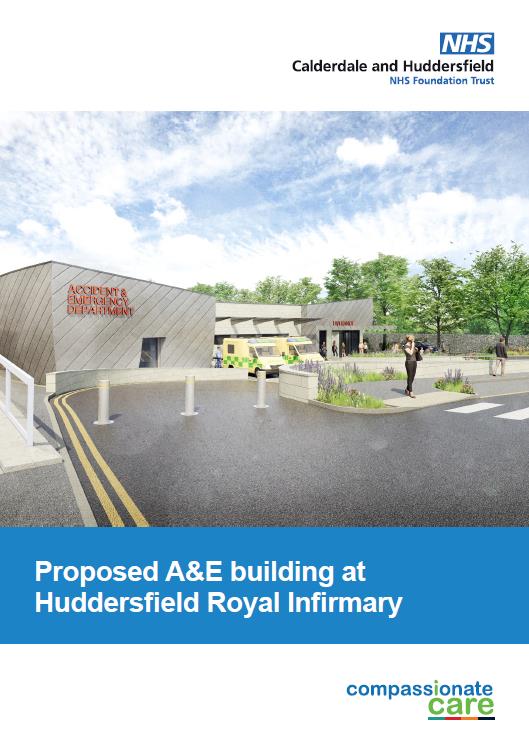
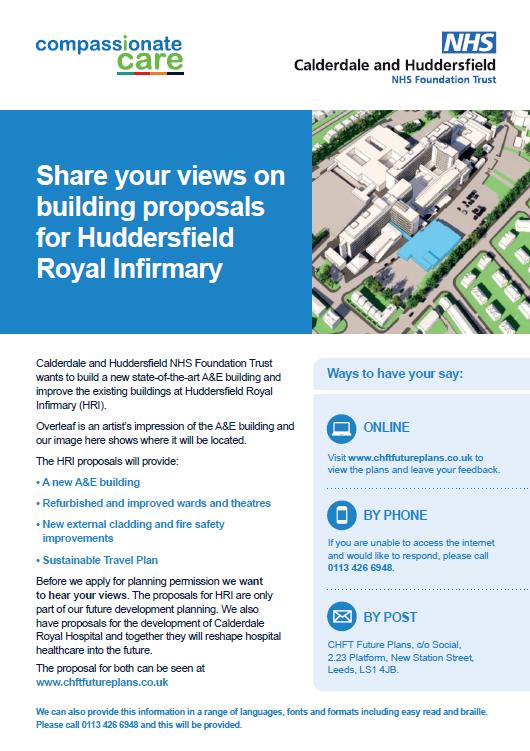
The leaflet above says:
Proposed A&E building at Huddersfield Royal Infirmary
Share your views on the building proposals for Huddersfield Royal Infirmary
Calderdale and Huddersfield NHS Foundation Trust wants to build a new state-of-the-art A&E building and improve the existing buildings at Huddersfield Royal Infirmary (HRI).
Overleaf is an artist’s impression of the A&E building and our image here shows where it will be located.
The HRI proposals will provide:
- A new A&E building
- Refurbished and improved wards and theatres
- New external cladding and fire safety improvements
- Sustainable Travel Plans
Before we apply for planning permission we want to hear your views. The proposals for HRI are only part of the future development planning/ We also have proposals for the development of Calderdale Royal Hospital and together they will reshape hospital healthcare into the future.
The proposal for both can be seen at www.chftfutureplans.co.uk
We can also provide this information in a range of languages, fonts and formats including easy read and braille. Please call 01134266948 and this will be provided.
Ways to have your say:
- Online: Visit www.chftfutureplans.co.uk to view the plans and leave your feedback
- By phone: If you are unable to access the internet and would like to respond, please call 01134266948
- By post: CHFT Future Plans, c/o Social, 2.23 Platform, New Station Street, Leeds, LS1 4JB
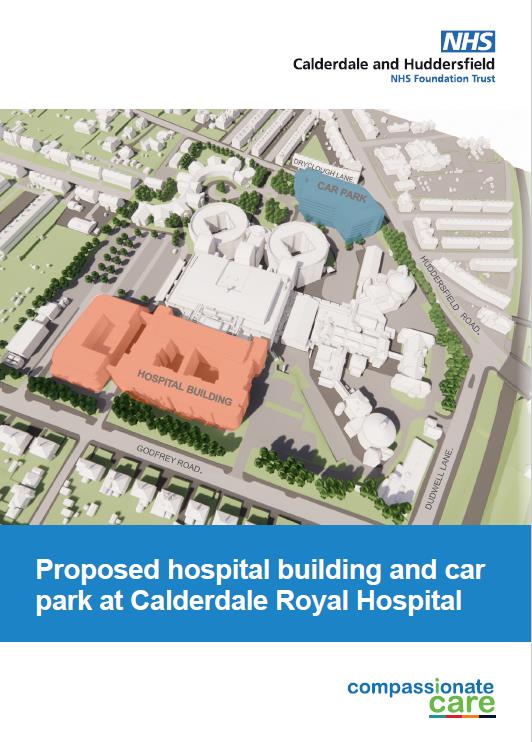

The leaflet above says:
Proposed hospital building and car park at Calderdale Royal Hospital
Share your views on the building proposals for Calderdale Royal Hospital
Calderdale and Huddersfield NHS Foundation Trust wants to build a new state-of-the-art hospital building and car park Calderdale Royal Hospital (CRH).
Our images shows where the new buildings will be located.
The CRH proposals will provide:
- A new A&E building
- A paediatric emergency department
- Extra wards, theatres and an enhanced intensive care unit
- A car park and Sustainable Travel Plans
Before we apply for planning permission we want to hear your views.
The proposals for CRH are only part of the future development planning. We also have proposals for the development of Huddersfield Royal Infirmary and together they will reshape hospital healthcare into the future.
The proposal for both can be seen at www.chftfutureplans.co.uk
We can also provide this information in a range of languages, fonts and formats including easy read and braille. Please call 01134266948 and this will be provided.
Ways to have your say:
- Online: Visit www.chftfutureplans.co.uk to view the plans and leave your feedback
- By phone: If you are unable to access the internet and would like to respond, please call 01134266948
- By post: CHFT Future Plans, c/o Social, 2.23 Platform, New Station Street, Leeds, LS1 4JB
Appendix 2 – Letter to Residents
The below letter was sent in the post to residents:
Dear Resident,
As you are a close neighbour of our hospitals, I am writing to share with you an update on our plans to improve services and buildings at Calderdale Royal Hospital (CRH) and at Huddersfield Royal Infirmary (HRI).
In one of the biggest investments in years, the Department of Health and Social Care has allocated us £196.5m to invest at our hospitals in Calderdale and Huddersfield and we are investing at both sites as summarised here:
At CRH, we want to build a new state-of-the-art healthcare building to the south of the hospital, and car parking to support. Our plans for CRH include:
- A new A&E department and paediatric emergency department
- Additional inpatient wards, operating theatres and a larger intensive care unit
- Increased parking with electric charging points on offer
At HRI we want to build a new state-of-the-art A&E department and improve and upgrade the existing 1960s buildings. Our plans for HRI include:
- A new A&E department
- Refurbished and improved wards and theatres
- Replacing external cladding and fire safety improvements and a wider maintenance programme across the estate
Together, these developments represent a very significant and lasting investment in healthcare services at both hospitals for all our residents right across Calderdale, Huddersfield and the wider region.
You can find out more detail, artists impressions, maps and the opportunity to leave feedback about the plans at www.chftfutureplans.co.uk. In May we plan to apply for planning permission to both Kirklees and Calderdale Council so do please take a look at the website.
If you have any further queries and would like to talk about the plans with us then please contact Matt Joy on 07388376267 who will be happy to arrange a conversation with you.
Yours sincerely,
Anna Basford
Director of Transformation, Calderdale and Huddersfield NHS Foundation Trust
We can provide any information in a range of formats including easy read, translation in a range of languages and braille so please contact Matt to request an alternative version.

